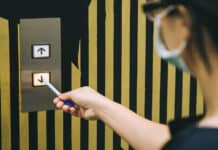In the age of COVID-19, building owners and facilities managers have had to address concerns over social distancing and disinfecting high-touch areas in commercial elevators. As a result, Stanley Elevator and CASPR Group are partnering to promote the CASPR 200e, a continuous, touch-free disinfectant technology designed exclusively for commercial elevators.
 “Elevators are essential, but they are also difficult to keep clean even with the most robust cleaning schedules,” said Ryan Hussey, VP of Operations for Stanley Elevator. “We knew we needed to do everything in our power to help our customers enhance their existing cleaning processes, because in apartment buildings, medical facilities, and hospitals, there isn’t always an alternate route.”
“Elevators are essential, but they are also difficult to keep clean even with the most robust cleaning schedules,” said Ryan Hussey, VP of Operations for Stanley Elevator. “We knew we needed to do everything in our power to help our customers enhance their existing cleaning processes, because in apartment buildings, medical facilities, and hospitals, there isn’t always an alternate route.”
Hussey and the rest of the Stanley Elevator team were introduced to CASPR Group, a health technology innovator that specializes in touch-free disinfection technology for the healthcare industry. Stanley Elevator and CASPR’s partnership began with the goal of testing and implementing an effective disinfecting technology designed for commercial elevators. When COVID-19 had reached pandemic levels, CASPR had introduced the CASPR 200e.
The CASPR 200e is a natural purifier installed inside the elevator cab that eliminates air pollution and illness-causing pathogens on surfaces (e.g., call buttons). Designed for elevators up to 200 square feet, it measures 10.38″ L x 1.25″ W x 2.25″ H and requires 100/240 VAC, 12 VDC.
 The CASPR 200e coverts humidity in the air from H2O (water) to H2O2 (hydrogen peroxide), and uses special UV lighting and a photocatalyst to create an advanced oxidation process and produces no ozone. The UV bulbs used typically have a life span of two years, but to maintain effectiveness it is recommended that they be replaced every year.
The CASPR 200e coverts humidity in the air from H2O (water) to H2O2 (hydrogen peroxide), and uses special UV lighting and a photocatalyst to create an advanced oxidation process and produces no ozone. The UV bulbs used typically have a life span of two years, but to maintain effectiveness it is recommended that they be replaced every year.
CASPR’s Natural Catalytic Conversion utilizes a multi-wavelength ultraviolet light to illuminate a target surface. The target surface is a honeycomb matrix treated with a proprietary photocatalytic coating. Together, the technology converts H2O and O2 in the air into safe but effective levels of Hydroxyl Radicals (OH-), Oxygen ions (O2-) and Hydrogen Peroxide (H2O2) dispersed throughout the elevator interior, coating all surfaces with oxidizing molecules that work to reduce the bioburdens of clinically relevant pathogens 24/7.
Although the CASPR 200e was not developed specifically for COVID-19, it has already proven to be effective against similar coronavirus, such as SARS and H1N1. In an elevator-specific study, the disinfectant technology showed up to a 99.9% kill rate against bacteria, viruses, mold, odors, and VOCs.
Stanley Elevator and CASPR tested the CASPR 200e in 10 elevators. They selected several settings throughout Massachusetts, including apartment buildings and college campuses, and the results indicated the technology worked as well in elevators as previously tested installation sites. All 10 sites showed reductions of up to 99% in pathogen levels on all high-touch surfaces and in the air.
John LaRochelle, Chief Executive Officer at Environmental Infection Production, a third-party company that tested and verified the results, stressed the importance of this technology. “Elevators create an impossible social distancing situation,” he said. “This technology helps create another level and layer of risk mitigation.”
For the most effective results, Stanley Elevator recommends using the CASPR 200e disinfectant technology in addition to regular cleaning and maintenance.
The CASPR 200e is available to elevator service companies and elevator owners through Stanley Innovation, which is Stanley Elevator’s technology partner and the exclusive distributor of the product for the elevator market.















![[VIDEO] Collect Asset Data at the Speed of Walking a Building](https://facilityexecutive.com/wp-content/uploads/2024/02/maxresdefault-324x160.jpg)